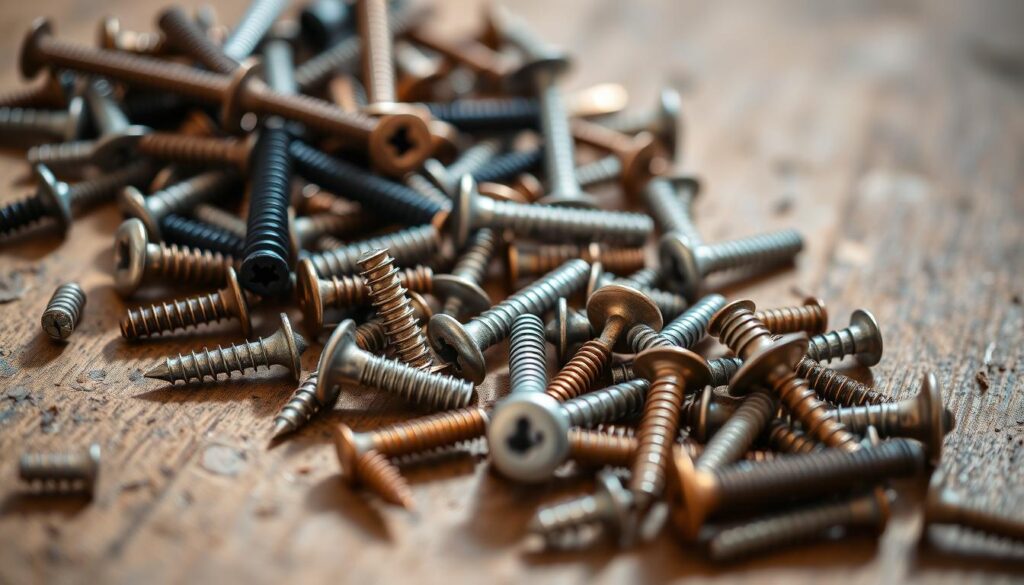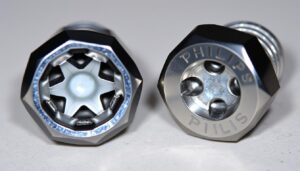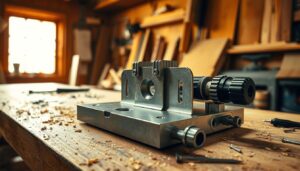Are you struggling to determine the ideal screw size for your woodworking projects, potentially compromising their structural integrity and aesthetic appeal?
Selecting the correct screw length is crucial for achieving a secure and stable connection in your woodwork. With various types of wood screws available, each designed for specific applications, understanding their components and measurements is vital.
This comprehensive guide will walk you through the fundamental principles of wood screws, helping you to understand how to select the perfect screw for your project, whether it’s for furniture assembly or deck construction.
Key Takeaways
- Understand the different types of wood screws and their applications.
- Learn how to measure screw length correctly.
- Discover the factors that influence screw length selection.
- Gain insights into the relationship between screw length and project durability.
- Acquire the knowledge to confidently select the perfect wood-screw length for any project.
Understanding Wood Screw Basics
Understanding the fundamentals of wood screws is crucial for any woodworking project. You need to know the different components and types of wood screws to ensure you’re using the right one for your specific needs.
What Are Wood Screws?
Wood screws are specialised fasteners designed specifically for joining wooden materials. They feature unique threading patterns that provide optimal grip in fibrous wood structures. Traditional wood screws have a tapered shank and a sharp point, making them easy to drive into wood.
Key Components of a Wood Screw
The key components of a wood screw include the head, shank, threads, and tip. The head can be flathead, roundhead, or speciality designs. The shank can be smooth or fully threaded, and the threads can be coarse or fine. Understanding these components is essential to choosing the right wood screw for your project.
Why Screw Length Matters in Woodworking
Screw length plays a vital role in determining the structural integrity and aesthetic appeal of your woodworking projects. The length of a screw refers to the distance from the tip to the head, and it’s crucial to choose a screw that is long enough to penetrate both pieces of wood being joined together.
Structural Integrity Concerns
Selecting the appropriate screw length is critical for maintaining the structural integrity of your woodworking projects. Screws that are too short may not provide sufficient holding power, potentially leading to joint failure under stress. On the other hand, screws that are too long can cause damage by protruding through the opposite side or splitting the wood, which can compromise the safety and durability of your workpiece.
Aesthetic Considerations
The aesthetic impact of screw length should not be overlooked. Visible screw tips or splitting caused by overly long screws can detract from the appearance of your finished projects. Proper screw length ensures a clean finish and maintains the visual appeal of your work. Some key points to consider include:
- Ensuring screws are not too long to avoid visible tips.
- Preventing splitting caused by screws that are too long.
- Maintaining a clean finish by choosing the right screw length.
Different Types of Wood Screws
Understanding the different types of wood screws is essential for any woodworking project. The variety in wood screws caters to different applications and materials, ensuring that you can find the perfect screw for your needs.
Traditional Wood Screws
Traditional wood screws feature a smooth shank near the head and a threaded portion near the tip. They are designed for joining solid wood pieces with maximum holding power.
Chipboard Screws
Chipboard screws have deep, coarse threads along their entire length, providing superior grip in manufactured wood products like MDF, particleboard, and chipboard.
Deck Screws
Deck screws are engineered for outdoor applications, featuring corrosion-resistant coatings or materials like stainless steel. They are designed to withstand exposure to moisture and harsh weather conditions.
By understanding the specific design features of different wood screw types, you can ensure that you select the appropriate fastener for your particular material and application.
Understanding Screw Measurements
The key to a successful woodworking project lies in understanding screw measurements and sizes. Accurate measurements ensure that your screws fit perfectly, providing the necessary holding power without splitting the wood.
Length Measurement Standards
Screw length is a critical measurement that determines how deeply the screw will penetrate the wood. For round-headed screws, the length is typically measured from under the head to the tip, while for flathead screws, it’s measured from the top of the head to the tip. Understanding these standards is essential for choosing the right screw length for your project.
Diameter and Gauge Explained
The diameter, or gauge, of a screw is another vital measurement. It determines the screw’s thickness and holding power. A larger diameter screw has a higher load-bearing capacity, making it suitable for heavy-duty applications. The gauge system can be counterintuitive, as smaller gauge numbers indicate larger diameters. For instance, a screw with a gauge of 6 is thicker than one with a gauge of 10.
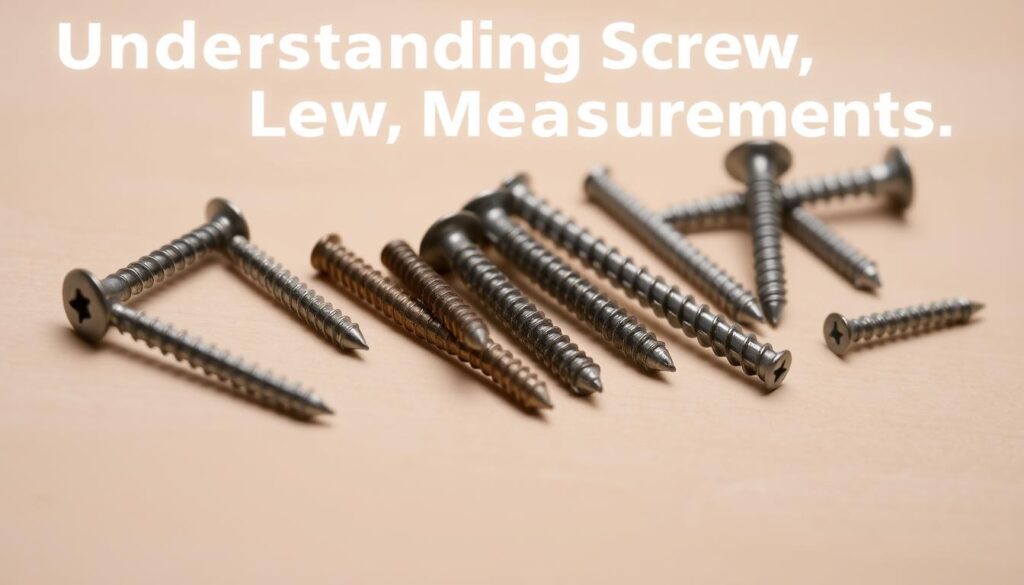
| Screw Gauge | Diameter (mm) | Typical Use |
|---|---|---|
| 6 | 3.5 | Heavy-duty applications |
| 8 | 4.2 | General woodworking |
| 10 | 4.8 | Light framing |
Properly interpreting screw size specifications is crucial for selecting the right screw for your project’s specific requirements. Different countries may use different measurement standards, with metric measurements common in the UK and Europe, and imperial measurements often used in North America.
The Rule of Thumb for Choosing Right Wood-Screw Length
The key to a successful woodworking project lies in understanding how to choose the right wood-screw length. For most projects, a widely accepted rule of thumb is applied to ensure the screw length is appropriate for the task.
The 2:1 Ratio Method
The 2:1 ratio method is a simple yet effective guideline. It suggests that the screw length should be approximately twice the thickness of the top board being joined. For instance, if you’re fastening a 1/2-inch thick board, you would ideally use a 1-inch long screw. This ensures adequate penetration into the second piece, providing a secure hold.
Adjusting for Different Wood Types
While the 2:1 ratio provides a reliable starting point, adjustments may be necessary based on the type of wood you’re working with. For hardwoods like oak or maple, you might need to adjust the ratio slightly downward to prevent splitting. In contrast, softwoods may accommodate slightly longer screws. Understanding the density and grain structure of different wood types is crucial for making these adjustments effectively.
Factors Affecting Screw Length Selection
When choosing the right screw length, several factors come into play to ensure a sturdy and durable joint. The type of wood, the weight and stress the joint will bear, and the type of joint itself all play crucial roles in determining the ideal screw length.
Wood Density and Hardness
Different types of wood have varying densities and characteristics, which significantly impact the choice of screw. For instance, softwoods like pine and cedar require screws with a coarser thread to provide sufficient grip, whereas hardwoods like oak and maple may require screws with a finer thread to prevent splitting.
Load-Bearing Requirements
The anticipated load-bearing requirements of your project should directly influence your screw length selection. Heavier loads necessitate longer screws that penetrate deeper into the supporting material, thereby enhancing the strength and stability of the joint.
Joint Type Considerations
Different joint types, such as butt joints, lap joints, and mitre joints, have unique structural requirements that affect the optimal screw length. For example, joints under greater stress require more substantial fastening, and environmental factors like humidity fluctuations and temperature changes can cause wood to expand and contract, impacting joint integrity over time.
The factors affecting screw length selection can be summarised as follows:
- Wood density significantly impacts screw selection, as denser hardwoods require stronger, potentially shorter screws.
- Load-bearing requirements directly influence screw length, with heavier loads requiring longer screws.
- Different joint types have unique requirements that affect optimal screw length for maximum strength and stability.
Selecting the Right Screw Head Type
Selecting the appropriate screw head is vital for ensuring that your woodworking projects are both durable and visually appealing. The type of screw head you choose can affect not only the appearance but also the structural integrity of your project.
Flathead vs. Roundhead
Flathead screws are designed to sit flush with or below the wood surface when properly countersunk, making them ideal for applications where a smooth finish is required. On the other hand, roundhead screws remain partially above the surface, providing a larger bearing surface that can be beneficial for softer woods or when distributing pressure over a wider area is necessary.
Speciality Heads for Specific Applications
There are various speciality head types designed for specific applications. For instance, trim heads offer less visible fastening due to their smaller diameter, while washer heads provide greater load distribution thanks to their built-in washer. The drive type, such as Phillips, Pozidriv, Torx, or square drive, also plays a crucial role in installation ease and resistance to cam-out. Modern drive types like Torx are particularly noteworthy for their superior torque transfer.
When choosing a screw head type, it’s essential to consider both the functional and aesthetic requirements of your project. The right screw head can enhance the overall quality and longevity of your work.
Material Compatibility Considerations
Different wood types and project environments demand careful consideration of screw materials to achieve optimal results. The right screw material can significantly enhance the durability and performance of your woodworking project.
Matching Screws to Wood Types
Various wood types require specific screw materials and coatings for optimal performance. For instance, hardwoods often necessitate stronger steel screws, while softwoods can accommodate a broader range of screw materials. It’s essential to match the screw type to the wood density and hardness to ensure a secure and lasting hold.
Corrosion Resistance for Different Environments
For outdoor or high-humidity applications, corrosion-resistant screws made from materials like stainless steel or silicon bronze are crucial. These materials offer superior durability and resistance to environmental degradation. In contrast, indoor projects in climate-controlled environments can typically use standard steel screws, although decorative or high-end projects might benefit from specialty materials like brass.
- Choose screws that are compatible with the chemical composition of the wood you’re using, as certain combinations can accelerate corrosion.
- Consider the interaction between screw materials and wood preservatives, stains, or treatments to avoid adverse reactions.
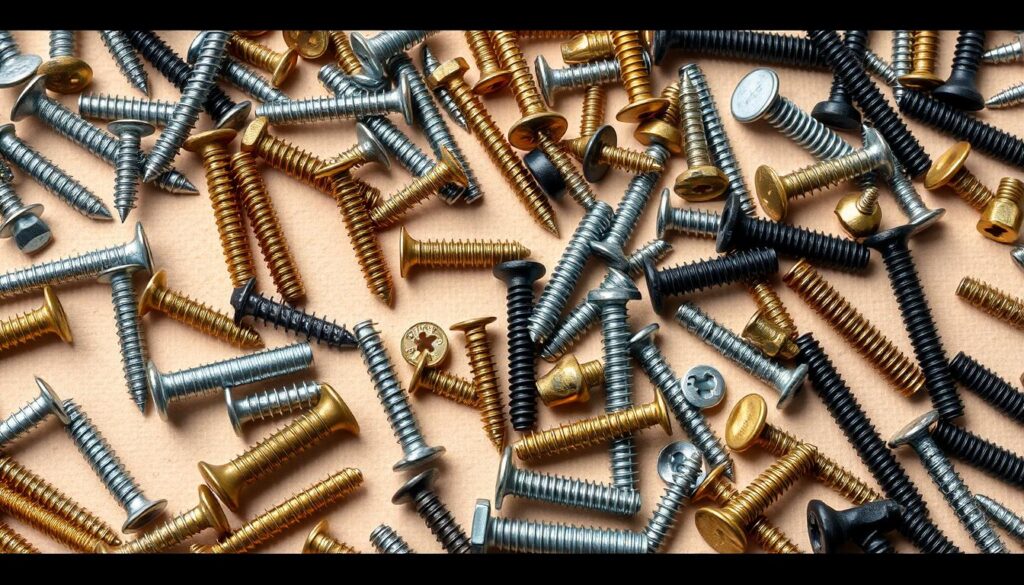
Common Mistakes When Choosing Screw Length
One of the most common mistakes in woodworking is selecting the wrong screw length, which can lead to a host of problems. Choosing the right screw length is crucial for ensuring the structural integrity and aesthetic appeal of your project.
Using Screws That Are Too Short
Using screws that are too short can result in insufficient penetration into the receiving material, creating weak joints that may fail under stress or over time. This can compromise the overall stability of your project.
Using Screws That Are Too Long
On the other hand, using screws that are too long can cause splitting or protrude through the opposite surface, creating safety hazards. It can also damage hidden elements like wiring or plumbing within walls.
Ignoring Wood Properties
Ignoring the specific properties of different wood types can lead to inappropriate screw selection. For instance, hardwoods often split when techniques appropriate for softwoods are applied. It’s essential to adjust your screw length and type according to the wood you’re working with.
As a general rule, always choose the appropriate screw size and type for your specific project. Over-tightening screws can strip the screw threads, weaken the joint, or damage the wood. Use firm and steady pressure, and stop tightening when the screw is snug.
Pre-Drilling Guidelines for Different Screw Lengths
When working with wood, pre-drilling is a crucial step that can make or break your project’s success. Pre-drilling pilot holes can prevent the wood from splitting, especially when working with hardwoods or near the edge of a board.
When to Pre-Drill
You should pre-drill when working with hardwoods, screwing near the edge of boards, using larger diameter screws, or when precise screw placement is required. This simple step can significantly improve the quality of your woodworking project.
Choosing the Right Drill Bit Size
The general rule for pilot hole sizing is to match the diameter of the screw’s inner shaft, allowing the threads to bite into the wood while preventing splitting. For longer screws, particularly in hardwoods, stepped pre-drilling can improve joint strength by allowing proper clamping action.
To ensure a seamless finish, especially when using flathead screws, countersink the holes to allow the screw heads to sit flush with the surface of the wood. This technique minimizes the risk of snagging or splintering.
| Screw Length | Drill Bit Size | Pre-Drilling Technique |
|---|---|---|
| Up to 1 inch | Slightly smaller than screw diameter | Standard pre-drilling |
| 1-2 inches | Matching screw inner shaft diameter | Stepped pre-drilling for hardwoods |
| Over 2 inches | Slightly larger than screw inner shaft diameter | Stepped pre-drilling with countersinking |
Different screw lengths and diameters require specific pre-drilling techniques. By choosing the right drill bit size and pre-drilling method, you can ensure a strong and durable joint in your woodworking project.
Project-Specific Screw Length Recommendations
To achieve professional-grade results, it’s essential to choose the right screw length for your specific project. The specific requirements of your project should also be taken into consideration. If you’re joining thin pieces of wood, choose screws with a shorter length to avoid protruding through the other side.
Furniture Assembly
Furniture assembly typically requires precise screw length selection to ensure joints are secure without protruding through visible surfaces. You can find suitable screws for this application at Trading Depot, which offers a range of multi-purpose wood screws.
Deck Construction
Deck construction demands corrosion-resistant screws of substantial length (typically 2-1/2″ to 3-1/2″) to secure decking to joists while withstanding outdoor conditions and structural loads.
Cabinet Making
Cabinet making requires particular attention to screw length, with face frame attachment typically using 1-1/4″ screws, while cabinet box assembly might use 1-5/8″ screws for proper holding power without penetration through visible surfaces.
For other DIY projects, such as shelving and wall-mounted applications, the screw length will vary based on the specific requirements. For instance, DIY shelving projects generally benefit from screws that penetrate at least 1″ into the supporting structure beyond the shelf thickness.
Conclusion
As you’ve learned throughout this guide, picking the right wood screw length is fundamental to achieving professional-grade woodworking results. By following the guidelines, including the 2:1 ratio method, and considering factors like wood type and joint requirements, you can ensure strong and secure joints in your projects. Remember to pre-drill appropriately sized holes, especially in hardwoods or near board edges, to prevent splitting. Different projects, such as furniture assembly or deck construction, have unique requirements, so adjust your approach accordingly. With practice, choosing the right wood-screw length will become second nature, leading to more durable and professional woodworking projects.
